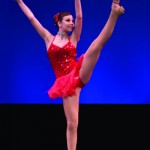
By LIA VILLAR
As lights illuminate the stage, four girls go over techniques, their bodies and muscles tightening with tension as time lingers, waiting for the curtain to rise to perform a long awaited routine.
“It’s really nerve racking [right before a competition] because everyone back stage is going through the dance but once I step on stage, all the nervousness goes away,” junior Morgan Carr said.
Carr started dancing at two years old. Her grandfather serves as her inspiration to continue dancing.
“He died when I was really young so I wanted to keep doing it [because] my grandpa loved to watch me dance,” Carr said.
Before going into competitions, practice is essentially a daily aspect for Carr, senior Alexis VanCura, sophomore Ashley Simkovitch and Tyler Cook, each have practice between five to seven days a week. Dancing not only takes dedication, but it also takes time away time from school work and their social lives.
“It takes up a lot of time on weekends. I’m not allowed to dance if my grades are low so my [dance] teachers are understanding if I can’t go to class,” Cook said.
Throughout the season, Carr, VanCura, Cook and Simkovitch all compete in the Regional Dance America which hosts 85 dance companies and over 3,000 dancers from across the nation.
In addition to competing in the Regional Dance America competitions, VanCura has participated in competitions such as Starlight, On Stage New York, Starpower, Hall of Fame and Encore.
“I competed [outside of Dancers Pointe] from the age of six to about 13. In competition, I did solos and I also competed in large groups called production numbers,” VanCura said.
Even though dancing requires physical input, numerous speculators believe dancing is not a sport.
“[They] have no idea how hard it is. You always need to keep your body healthy and in shape. I mean, many football players go to ballet to get stronger, so why wouldn’t it be a sport,” Simkovitch said.
The girls believe dancing is an art that requires athletic ability.
“You have to stay in shape to dance. A dancer [has to be] muscularly fit because dancers use their muscles and core more than anything else,” VanCura said.
Without athletic ability and endurance, dancers are in danger of injuring themselves.
“Dance is hard on your body. I have tendentious in both of my hips and I’m afraid that will lead to health issues but I don’t think any us would stop dancing because of our injuries,” Carr said.
Dancing in competitions not only demands practice but requires the girls to have rhythm, be in shape and know how to apply the leaps, jumps and turns dancing entails.
“A dancer has to prepared to be corrected. No one is perfect and there is always room for improvement. A dancer’s heart also has to be in this, you have to develop a passion for this art to be able to succeed,” VanCura said.
//